Public Health Nursing Essay: Cardiovascular Disease Challenges
VerifiedAdded on 2023/06/04
|8
|2033
|117
Essay
AI Summary
This essay addresses the significant public health challenge of cardiovascular disease (CVD) in Australia, detailing its effects on individuals, communities, and the broader society, including health, welfare, social justice, and economic costs. It emphasizes the importance of this public health issue, highlighting that CVD accounts for a substantial portion of deaths and healthcare expenditures. The essay explores modifiable risk factors such as poor diet, lack of exercise, smoking, and high blood pressure, and suggests countermeasures based on the Health Belief Model. These include promoting healthier lifestyles, implementing population-based approaches, and strengthening the healthcare system. The role of nurses in patient education, therapeutic communication, and chronic care management is also emphasized, alongside the importance of policy and legislative interventions to reduce tobacco consumption and promote healthy eating. The essay concludes by advocating for integrated strategies involving healthcare infrastructure improvements and community-level interventions to mitigate the burden of CVD in Australia. Desklib provides access to this and many other student contributed assignments.

Running head: PUBLIC HEALTH NURSING
Public health nursing
Name of the student:
Name of the university
Author note:
Public health nursing
Name of the student:
Name of the university
Author note:
Paraphrase This Document
Need a fresh take? Get an instant paraphrase of this document with our AI Paraphraser
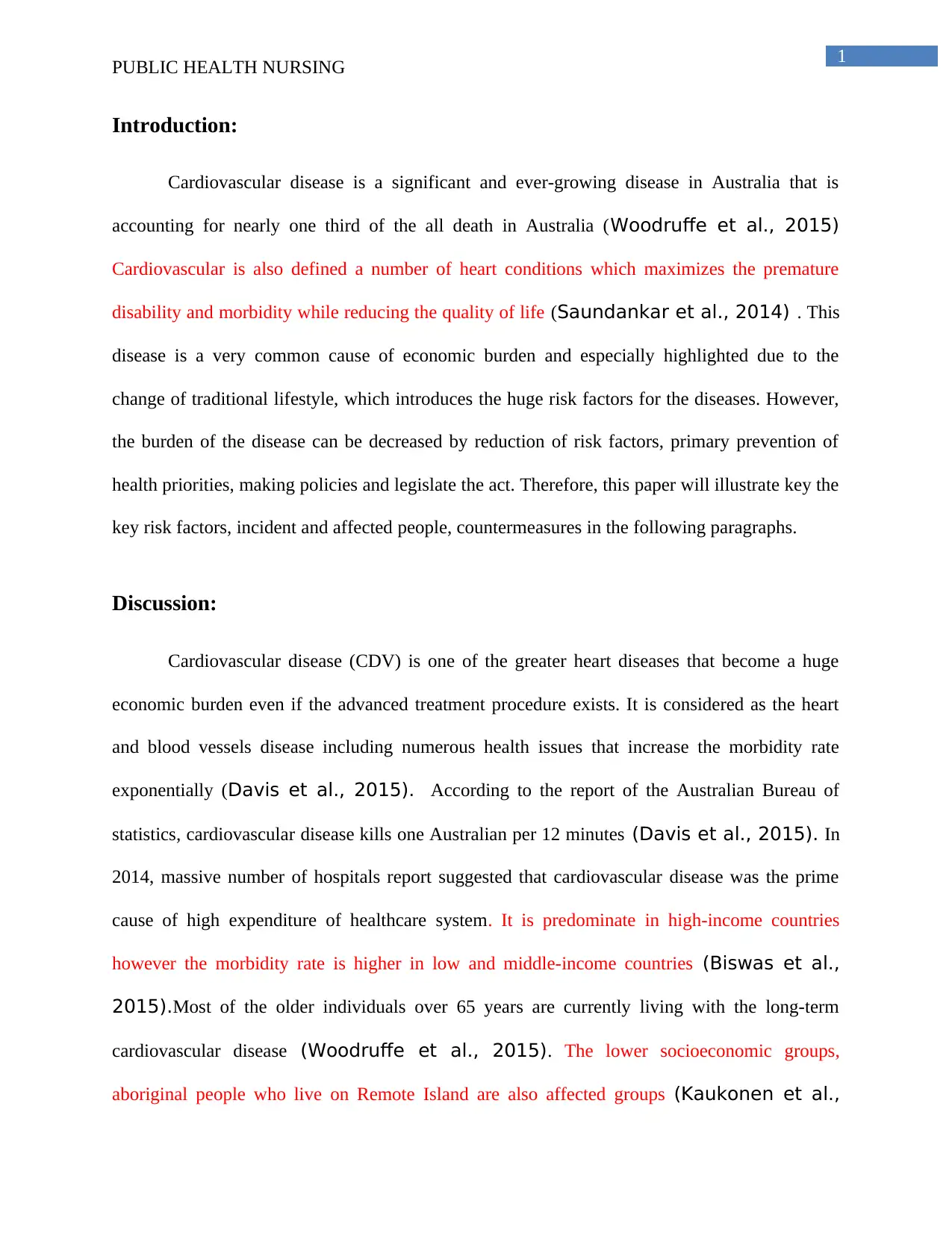
1
PUBLIC HEALTH NURSING
Introduction:
Cardiovascular disease is a significant and ever-growing disease in Australia that is
accounting for nearly one third of the all death in Australia (Woodruffe et al., 2015)
Cardiovascular is also defined a number of heart conditions which maximizes the premature
disability and morbidity while reducing the quality of life (Saundankar et al., 2014) . This
disease is a very common cause of economic burden and especially highlighted due to the
change of traditional lifestyle, which introduces the huge risk factors for the diseases. However,
the burden of the disease can be decreased by reduction of risk factors, primary prevention of
health priorities, making policies and legislate the act. Therefore, this paper will illustrate key the
key risk factors, incident and affected people, countermeasures in the following paragraphs.
Discussion:
Cardiovascular disease (CDV) is one of the greater heart diseases that become a huge
economic burden even if the advanced treatment procedure exists. It is considered as the heart
and blood vessels disease including numerous health issues that increase the morbidity rate
exponentially (Davis et al., 2015). According to the report of the Australian Bureau of
statistics, cardiovascular disease kills one Australian per 12 minutes (Davis et al., 2015). In
2014, massive number of hospitals report suggested that cardiovascular disease was the prime
cause of high expenditure of healthcare system. It is predominate in high-income countries
however the morbidity rate is higher in low and middle-income countries (Biswas et al.,
2015).Most of the older individuals over 65 years are currently living with the long-term
cardiovascular disease (Woodruffe et al., 2015). The lower socioeconomic groups,
aboriginal people who live on Remote Island are also affected groups (Kaukonen et al.,
PUBLIC HEALTH NURSING
Introduction:
Cardiovascular disease is a significant and ever-growing disease in Australia that is
accounting for nearly one third of the all death in Australia (Woodruffe et al., 2015)
Cardiovascular is also defined a number of heart conditions which maximizes the premature
disability and morbidity while reducing the quality of life (Saundankar et al., 2014) . This
disease is a very common cause of economic burden and especially highlighted due to the
change of traditional lifestyle, which introduces the huge risk factors for the diseases. However,
the burden of the disease can be decreased by reduction of risk factors, primary prevention of
health priorities, making policies and legislate the act. Therefore, this paper will illustrate key the
key risk factors, incident and affected people, countermeasures in the following paragraphs.
Discussion:
Cardiovascular disease (CDV) is one of the greater heart diseases that become a huge
economic burden even if the advanced treatment procedure exists. It is considered as the heart
and blood vessels disease including numerous health issues that increase the morbidity rate
exponentially (Davis et al., 2015). According to the report of the Australian Bureau of
statistics, cardiovascular disease kills one Australian per 12 minutes (Davis et al., 2015). In
2014, massive number of hospitals report suggested that cardiovascular disease was the prime
cause of high expenditure of healthcare system. It is predominate in high-income countries
however the morbidity rate is higher in low and middle-income countries (Biswas et al.,
2015).Most of the older individuals over 65 years are currently living with the long-term
cardiovascular disease (Woodruffe et al., 2015). The lower socioeconomic groups,
aboriginal people who live on Remote Island are also affected groups (Kaukonen et al.,
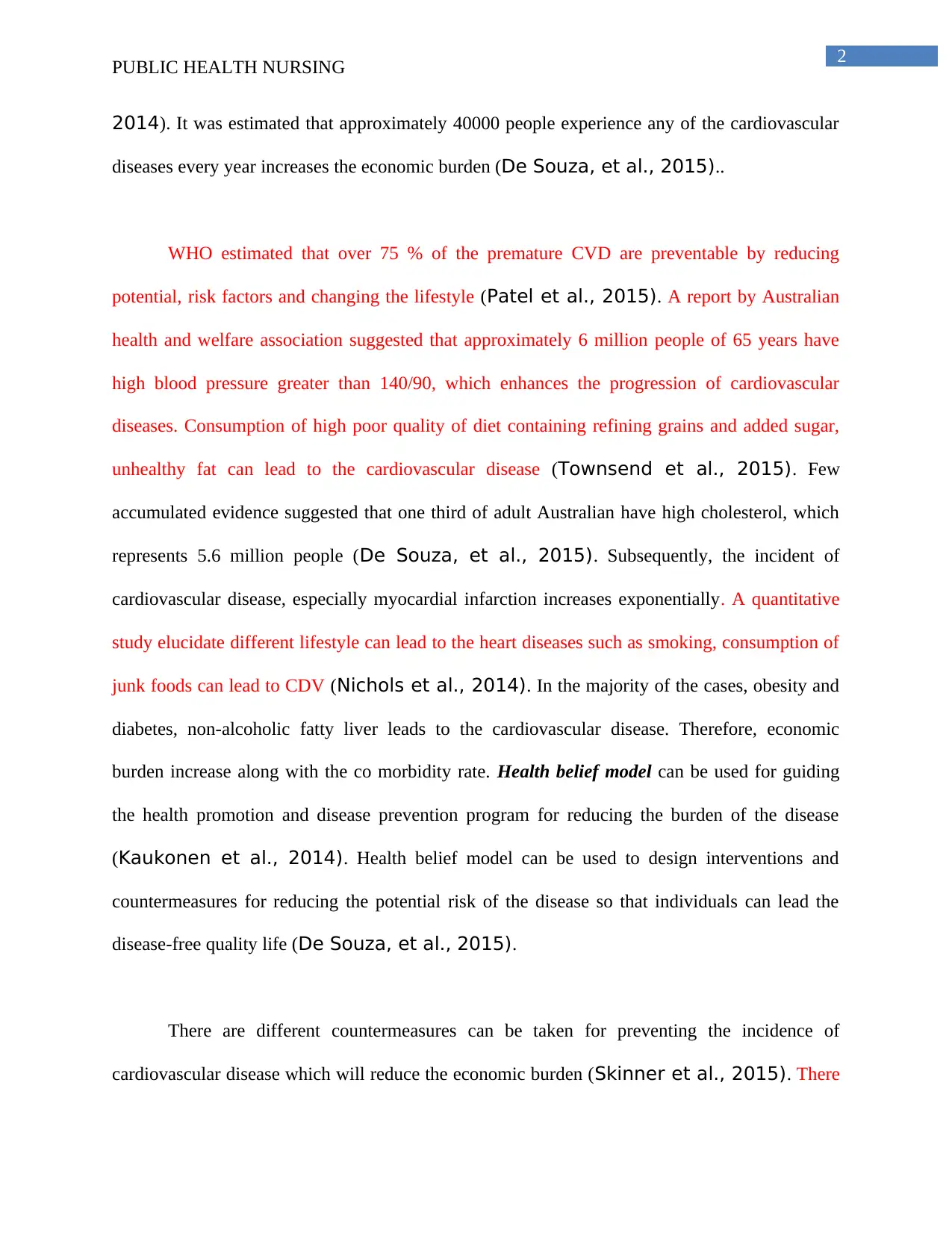
2
PUBLIC HEALTH NURSING
2014). It was estimated that approximately 40000 people experience any of the cardiovascular
diseases every year increases the economic burden (De Souza, et al., 2015)..
WHO estimated that over 75 % of the premature CVD are preventable by reducing
potential, risk factors and changing the lifestyle (Patel et al., 2015). A report by Australian
health and welfare association suggested that approximately 6 million people of 65 years have
high blood pressure greater than 140/90, which enhances the progression of cardiovascular
diseases. Consumption of high poor quality of diet containing refining grains and added sugar,
unhealthy fat can lead to the cardiovascular disease (Townsend et al., 2015). Few
accumulated evidence suggested that one third of adult Australian have high cholesterol, which
represents 5.6 million people (De Souza, et al., 2015). Subsequently, the incident of
cardiovascular disease, especially myocardial infarction increases exponentially. A quantitative
study elucidate different lifestyle can lead to the heart diseases such as smoking, consumption of
junk foods can lead to CDV (Nichols et al., 2014). In the majority of the cases, obesity and
diabetes, non-alcoholic fatty liver leads to the cardiovascular disease. Therefore, economic
burden increase along with the co morbidity rate. Health belief model can be used for guiding
the health promotion and disease prevention program for reducing the burden of the disease
(Kaukonen et al., 2014). Health belief model can be used to design interventions and
countermeasures for reducing the potential risk of the disease so that individuals can lead the
disease-free quality life (De Souza, et al., 2015).
There are different countermeasures can be taken for preventing the incidence of
cardiovascular disease which will reduce the economic burden (Skinner et al., 2015). There
PUBLIC HEALTH NURSING
2014). It was estimated that approximately 40000 people experience any of the cardiovascular
diseases every year increases the economic burden (De Souza, et al., 2015)..
WHO estimated that over 75 % of the premature CVD are preventable by reducing
potential, risk factors and changing the lifestyle (Patel et al., 2015). A report by Australian
health and welfare association suggested that approximately 6 million people of 65 years have
high blood pressure greater than 140/90, which enhances the progression of cardiovascular
diseases. Consumption of high poor quality of diet containing refining grains and added sugar,
unhealthy fat can lead to the cardiovascular disease (Townsend et al., 2015). Few
accumulated evidence suggested that one third of adult Australian have high cholesterol, which
represents 5.6 million people (De Souza, et al., 2015). Subsequently, the incident of
cardiovascular disease, especially myocardial infarction increases exponentially. A quantitative
study elucidate different lifestyle can lead to the heart diseases such as smoking, consumption of
junk foods can lead to CDV (Nichols et al., 2014). In the majority of the cases, obesity and
diabetes, non-alcoholic fatty liver leads to the cardiovascular disease. Therefore, economic
burden increase along with the co morbidity rate. Health belief model can be used for guiding
the health promotion and disease prevention program for reducing the burden of the disease
(Kaukonen et al., 2014). Health belief model can be used to design interventions and
countermeasures for reducing the potential risk of the disease so that individuals can lead the
disease-free quality life (De Souza, et al., 2015).
There are different countermeasures can be taken for preventing the incidence of
cardiovascular disease which will reduce the economic burden (Skinner et al., 2015). There
⊘ This is a preview!⊘
Do you want full access?
Subscribe today to unlock all pages.

Trusted by 1+ million students worldwide
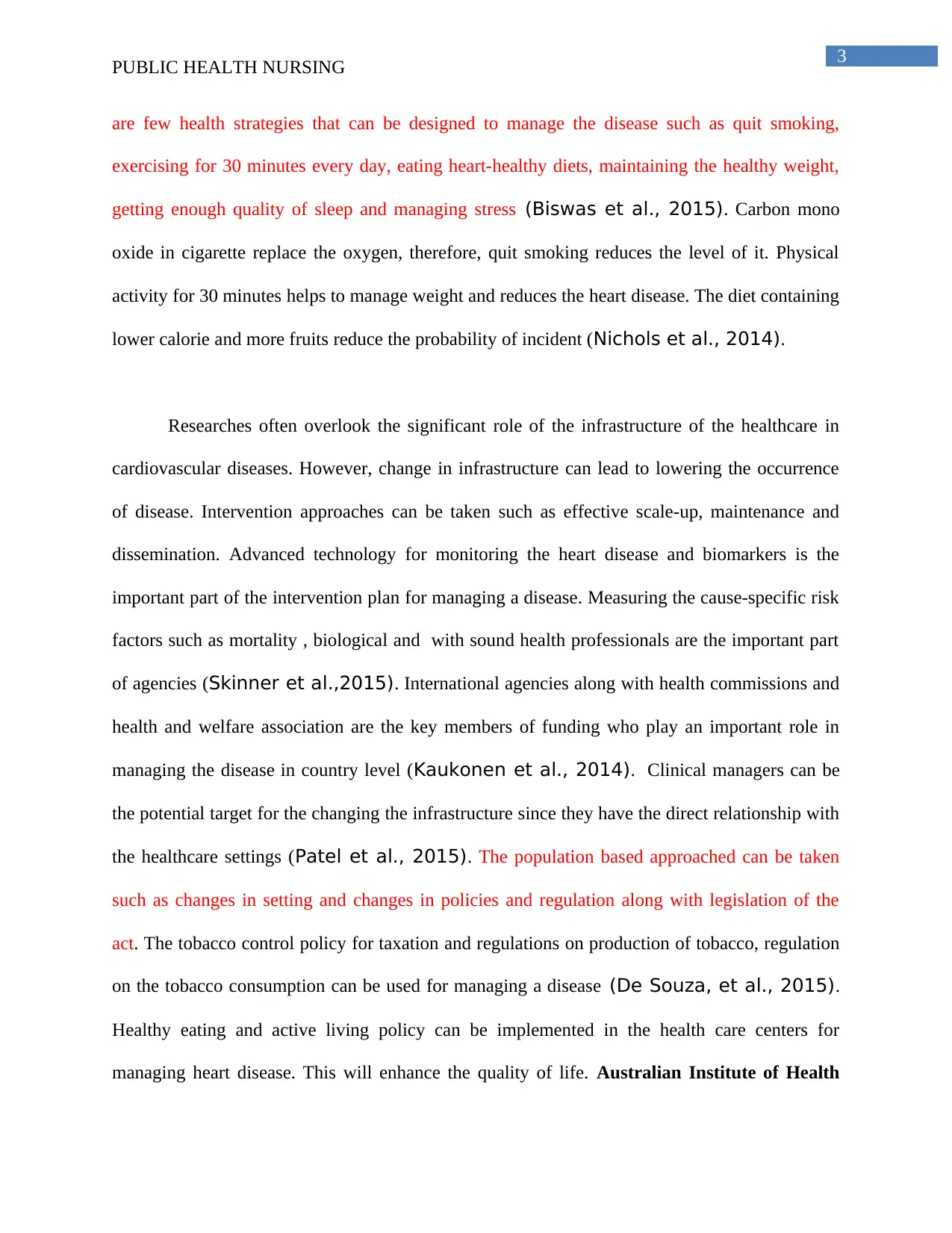
3
PUBLIC HEALTH NURSING
are few health strategies that can be designed to manage the disease such as quit smoking,
exercising for 30 minutes every day, eating heart-healthy diets, maintaining the healthy weight,
getting enough quality of sleep and managing stress (Biswas et al., 2015). Carbon mono
oxide in cigarette replace the oxygen, therefore, quit smoking reduces the level of it. Physical
activity for 30 minutes helps to manage weight and reduces the heart disease. The diet containing
lower calorie and more fruits reduce the probability of incident (Nichols et al., 2014).
Researches often overlook the significant role of the infrastructure of the healthcare in
cardiovascular diseases. However, change in infrastructure can lead to lowering the occurrence
of disease. Intervention approaches can be taken such as effective scale-up, maintenance and
dissemination. Advanced technology for monitoring the heart disease and biomarkers is the
important part of the intervention plan for managing a disease. Measuring the cause-specific risk
factors such as mortality , biological and with sound health professionals are the important part
of agencies (Skinner et al.,2015). International agencies along with health commissions and
health and welfare association are the key members of funding who play an important role in
managing the disease in country level (Kaukonen et al., 2014). Clinical managers can be
the potential target for the changing the infrastructure since they have the direct relationship with
the healthcare settings (Patel et al., 2015). The population based approached can be taken
such as changes in setting and changes in policies and regulation along with legislation of the
act. The tobacco control policy for taxation and regulations on production of tobacco, regulation
on the tobacco consumption can be used for managing a disease (De Souza, et al., 2015).
Healthy eating and active living policy can be implemented in the health care centers for
managing heart disease. This will enhance the quality of life. Australian Institute of Health
PUBLIC HEALTH NURSING
are few health strategies that can be designed to manage the disease such as quit smoking,
exercising for 30 minutes every day, eating heart-healthy diets, maintaining the healthy weight,
getting enough quality of sleep and managing stress (Biswas et al., 2015). Carbon mono
oxide in cigarette replace the oxygen, therefore, quit smoking reduces the level of it. Physical
activity for 30 minutes helps to manage weight and reduces the heart disease. The diet containing
lower calorie and more fruits reduce the probability of incident (Nichols et al., 2014).
Researches often overlook the significant role of the infrastructure of the healthcare in
cardiovascular diseases. However, change in infrastructure can lead to lowering the occurrence
of disease. Intervention approaches can be taken such as effective scale-up, maintenance and
dissemination. Advanced technology for monitoring the heart disease and biomarkers is the
important part of the intervention plan for managing a disease. Measuring the cause-specific risk
factors such as mortality , biological and with sound health professionals are the important part
of agencies (Skinner et al.,2015). International agencies along with health commissions and
health and welfare association are the key members of funding who play an important role in
managing the disease in country level (Kaukonen et al., 2014). Clinical managers can be
the potential target for the changing the infrastructure since they have the direct relationship with
the healthcare settings (Patel et al., 2015). The population based approached can be taken
such as changes in setting and changes in policies and regulation along with legislation of the
act. The tobacco control policy for taxation and regulations on production of tobacco, regulation
on the tobacco consumption can be used for managing a disease (De Souza, et al., 2015).
Healthy eating and active living policy can be implemented in the health care centers for
managing heart disease. This will enhance the quality of life. Australian Institute of Health
Paraphrase This Document
Need a fresh take? Get an instant paraphrase of this document with our AI Paraphraser
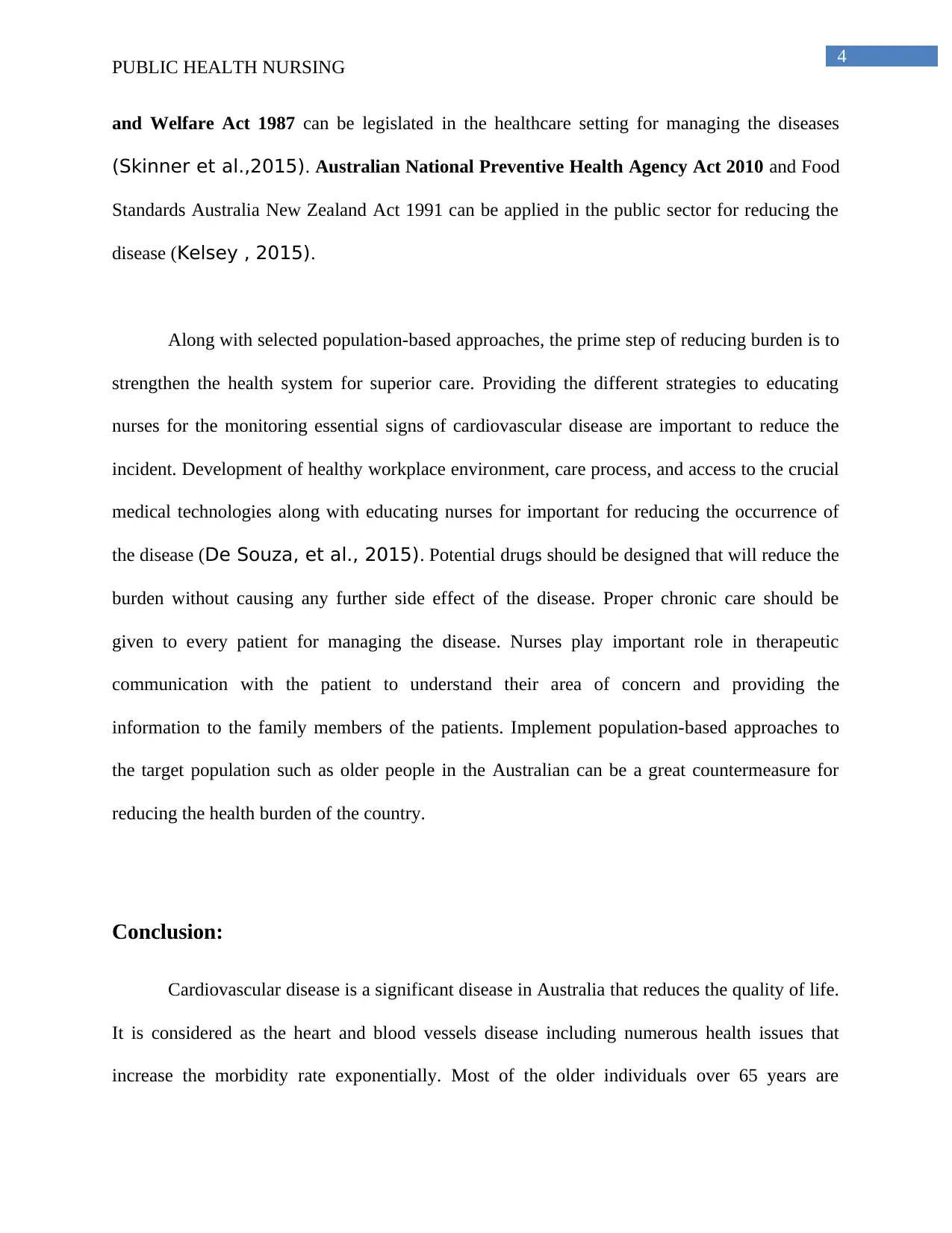
4
PUBLIC HEALTH NURSING
and Welfare Act 1987 can be legislated in the healthcare setting for managing the diseases
(Skinner et al.,2015). Australian National Preventive Health Agency Act 2010 and Food
Standards Australia New Zealand Act 1991 can be applied in the public sector for reducing the
disease (Kelsey , 2015).
Along with selected population-based approaches, the prime step of reducing burden is to
strengthen the health system for superior care. Providing the different strategies to educating
nurses for the monitoring essential signs of cardiovascular disease are important to reduce the
incident. Development of healthy workplace environment, care process, and access to the crucial
medical technologies along with educating nurses for important for reducing the occurrence of
the disease (De Souza, et al., 2015). Potential drugs should be designed that will reduce the
burden without causing any further side effect of the disease. Proper chronic care should be
given to every patient for managing the disease. Nurses play important role in therapeutic
communication with the patient to understand their area of concern and providing the
information to the family members of the patients. Implement population-based approaches to
the target population such as older people in the Australian can be a great countermeasure for
reducing the health burden of the country.
Conclusion:
Cardiovascular disease is a significant disease in Australia that reduces the quality of life.
It is considered as the heart and blood vessels disease including numerous health issues that
increase the morbidity rate exponentially. Most of the older individuals over 65 years are
PUBLIC HEALTH NURSING
and Welfare Act 1987 can be legislated in the healthcare setting for managing the diseases
(Skinner et al.,2015). Australian National Preventive Health Agency Act 2010 and Food
Standards Australia New Zealand Act 1991 can be applied in the public sector for reducing the
disease (Kelsey , 2015).
Along with selected population-based approaches, the prime step of reducing burden is to
strengthen the health system for superior care. Providing the different strategies to educating
nurses for the monitoring essential signs of cardiovascular disease are important to reduce the
incident. Development of healthy workplace environment, care process, and access to the crucial
medical technologies along with educating nurses for important for reducing the occurrence of
the disease (De Souza, et al., 2015). Potential drugs should be designed that will reduce the
burden without causing any further side effect of the disease. Proper chronic care should be
given to every patient for managing the disease. Nurses play important role in therapeutic
communication with the patient to understand their area of concern and providing the
information to the family members of the patients. Implement population-based approaches to
the target population such as older people in the Australian can be a great countermeasure for
reducing the health burden of the country.
Conclusion:
Cardiovascular disease is a significant disease in Australia that reduces the quality of life.
It is considered as the heart and blood vessels disease including numerous health issues that
increase the morbidity rate exponentially. Most of the older individuals over 65 years are
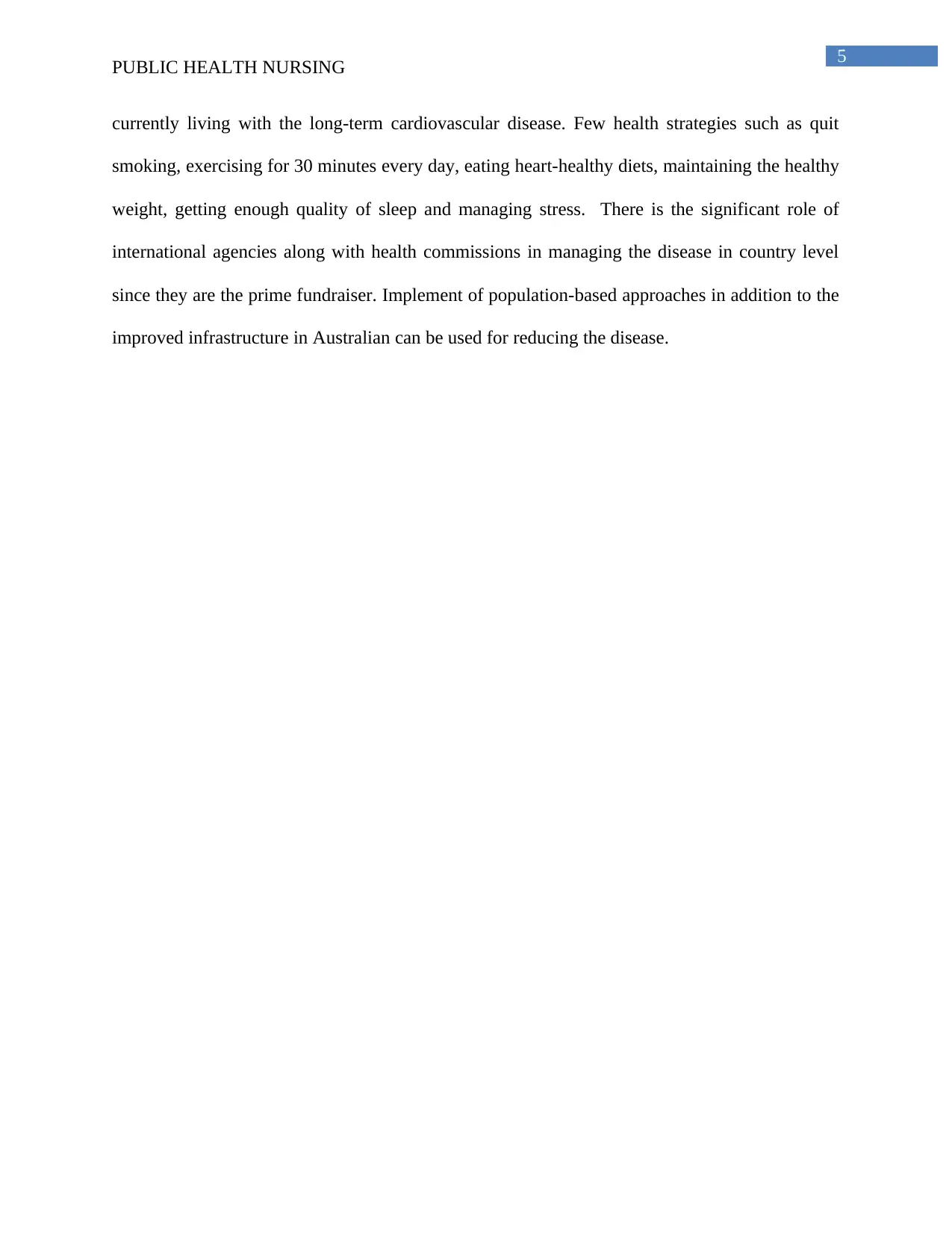
5
PUBLIC HEALTH NURSING
currently living with the long-term cardiovascular disease. Few health strategies such as quit
smoking, exercising for 30 minutes every day, eating heart-healthy diets, maintaining the healthy
weight, getting enough quality of sleep and managing stress. There is the significant role of
international agencies along with health commissions in managing the disease in country level
since they are the prime fundraiser. Implement of population-based approaches in addition to the
improved infrastructure in Australian can be used for reducing the disease.
PUBLIC HEALTH NURSING
currently living with the long-term cardiovascular disease. Few health strategies such as quit
smoking, exercising for 30 minutes every day, eating heart-healthy diets, maintaining the healthy
weight, getting enough quality of sleep and managing stress. There is the significant role of
international agencies along with health commissions in managing the disease in country level
since they are the prime fundraiser. Implement of population-based approaches in addition to the
improved infrastructure in Australian can be used for reducing the disease.
⊘ This is a preview!⊘
Do you want full access?
Subscribe today to unlock all pages.

Trusted by 1+ million students worldwide
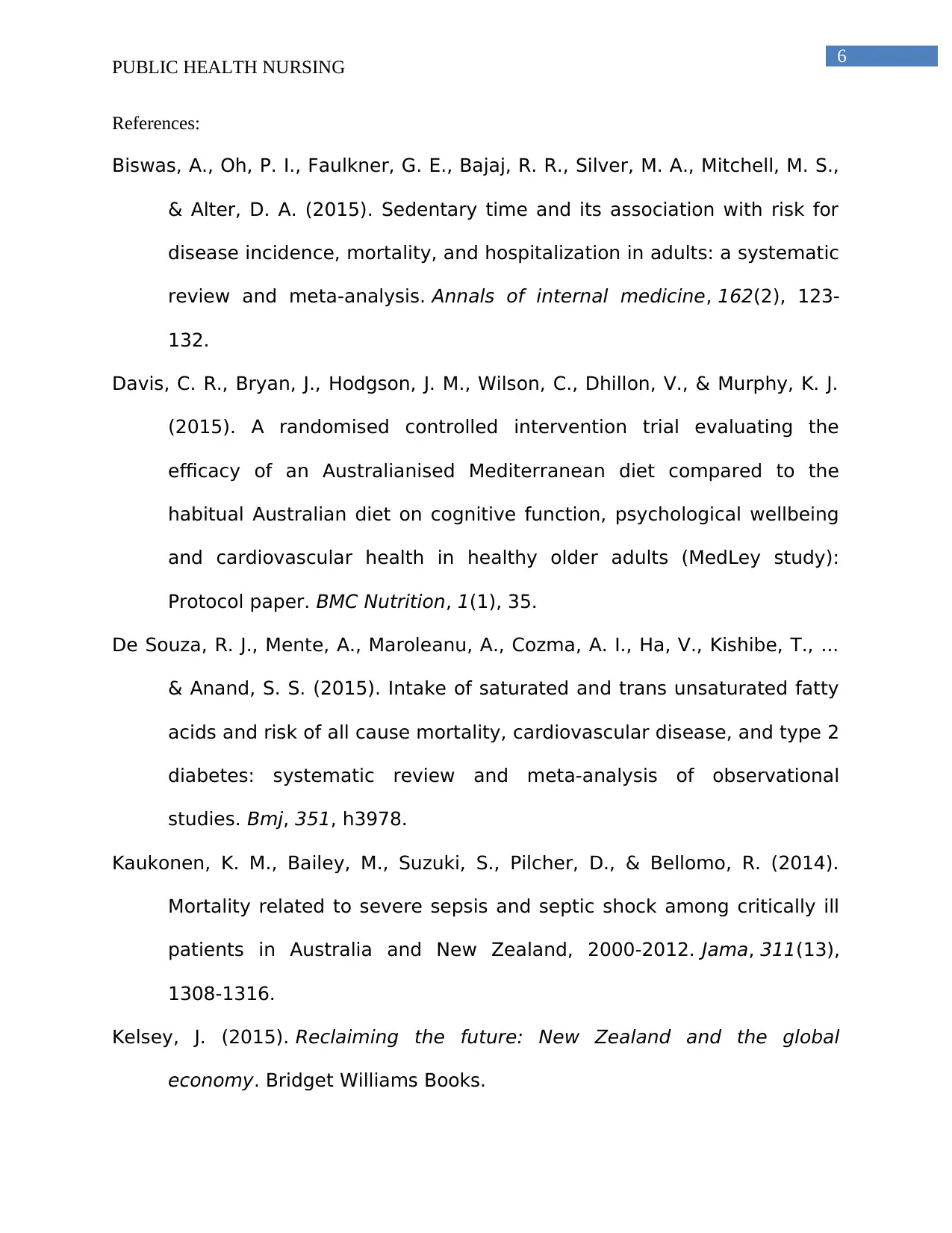
6
PUBLIC HEALTH NURSING
References:
Biswas, A., Oh, P. I., Faulkner, G. E., Bajaj, R. R., Silver, M. A., Mitchell, M. S.,
& Alter, D. A. (2015). Sedentary time and its association with risk for
disease incidence, mortality, and hospitalization in adults: a systematic
review and meta-analysis. Annals of internal medicine, 162(2), 123-
132.
Davis, C. R., Bryan, J., Hodgson, J. M., Wilson, C., Dhillon, V., & Murphy, K. J.
(2015). A randomised controlled intervention trial evaluating the
efficacy of an Australianised Mediterranean diet compared to the
habitual Australian diet on cognitive function, psychological wellbeing
and cardiovascular health in healthy older adults (MedLey study):
Protocol paper. BMC Nutrition, 1(1), 35.
De Souza, R. J., Mente, A., Maroleanu, A., Cozma, A. I., Ha, V., Kishibe, T., ...
& Anand, S. S. (2015). Intake of saturated and trans unsaturated fatty
acids and risk of all cause mortality, cardiovascular disease, and type 2
diabetes: systematic review and meta-analysis of observational
studies. Bmj, 351, h3978.
Kaukonen, K. M., Bailey, M., Suzuki, S., Pilcher, D., & Bellomo, R. (2014).
Mortality related to severe sepsis and septic shock among critically ill
patients in Australia and New Zealand, 2000-2012. Jama, 311(13),
1308-1316.
Kelsey, J. (2015). Reclaiming the future: New Zealand and the global
economy. Bridget Williams Books.
PUBLIC HEALTH NURSING
References:
Biswas, A., Oh, P. I., Faulkner, G. E., Bajaj, R. R., Silver, M. A., Mitchell, M. S.,
& Alter, D. A. (2015). Sedentary time and its association with risk for
disease incidence, mortality, and hospitalization in adults: a systematic
review and meta-analysis. Annals of internal medicine, 162(2), 123-
132.
Davis, C. R., Bryan, J., Hodgson, J. M., Wilson, C., Dhillon, V., & Murphy, K. J.
(2015). A randomised controlled intervention trial evaluating the
efficacy of an Australianised Mediterranean diet compared to the
habitual Australian diet on cognitive function, psychological wellbeing
and cardiovascular health in healthy older adults (MedLey study):
Protocol paper. BMC Nutrition, 1(1), 35.
De Souza, R. J., Mente, A., Maroleanu, A., Cozma, A. I., Ha, V., Kishibe, T., ...
& Anand, S. S. (2015). Intake of saturated and trans unsaturated fatty
acids and risk of all cause mortality, cardiovascular disease, and type 2
diabetes: systematic review and meta-analysis of observational
studies. Bmj, 351, h3978.
Kaukonen, K. M., Bailey, M., Suzuki, S., Pilcher, D., & Bellomo, R. (2014).
Mortality related to severe sepsis and septic shock among critically ill
patients in Australia and New Zealand, 2000-2012. Jama, 311(13),
1308-1316.
Kelsey, J. (2015). Reclaiming the future: New Zealand and the global
economy. Bridget Williams Books.
Paraphrase This Document
Need a fresh take? Get an instant paraphrase of this document with our AI Paraphraser
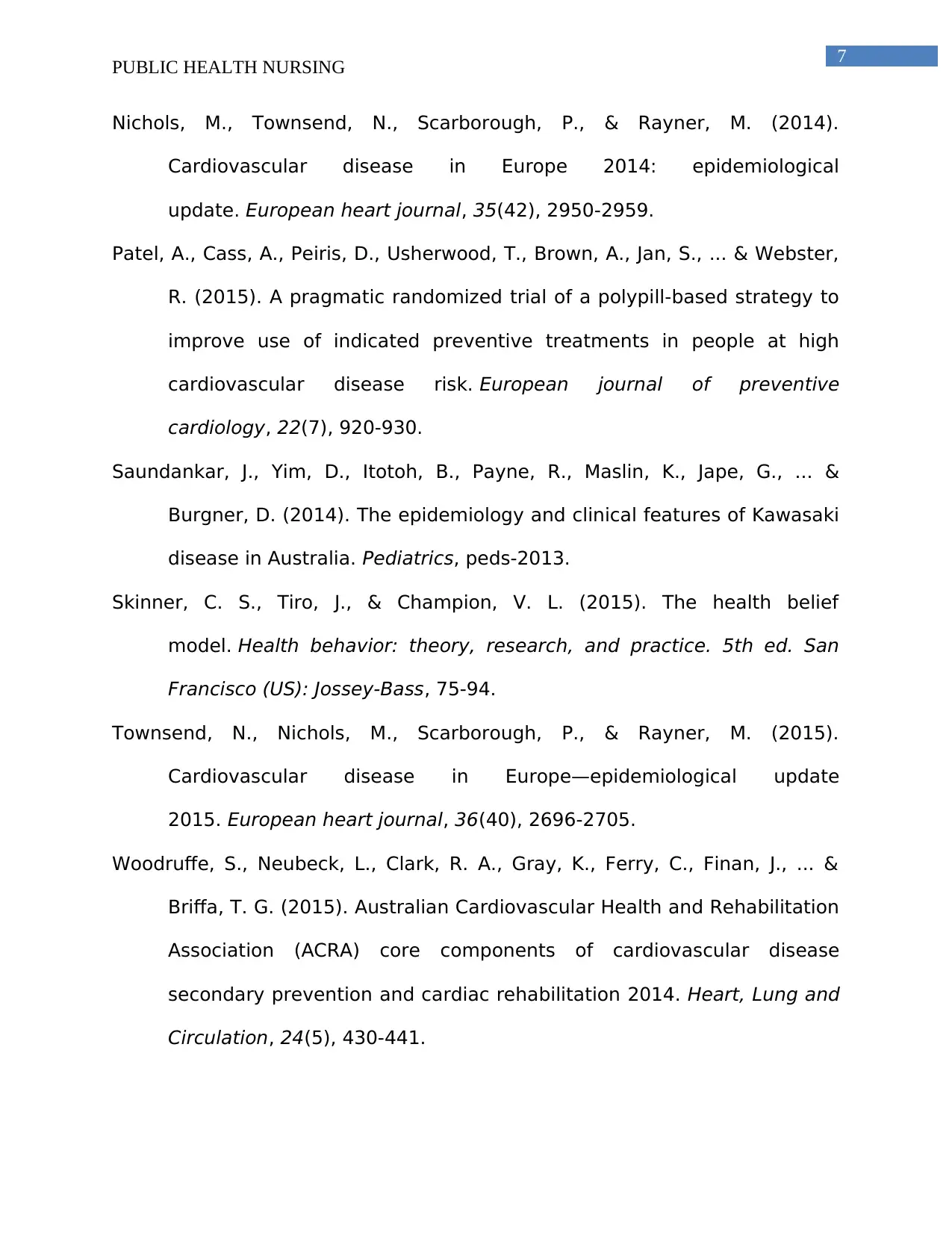
7
PUBLIC HEALTH NURSING
Nichols, M., Townsend, N., Scarborough, P., & Rayner, M. (2014).
Cardiovascular disease in Europe 2014: epidemiological
update. European heart journal, 35(42), 2950-2959.
Patel, A., Cass, A., Peiris, D., Usherwood, T., Brown, A., Jan, S., ... & Webster,
R. (2015). A pragmatic randomized trial of a polypill-based strategy to
improve use of indicated preventive treatments in people at high
cardiovascular disease risk. European journal of preventive
cardiology, 22(7), 920-930.
Saundankar, J., Yim, D., Itotoh, B., Payne, R., Maslin, K., Jape, G., ... &
Burgner, D. (2014). The epidemiology and clinical features of Kawasaki
disease in Australia. Pediatrics, peds-2013.
Skinner, C. S., Tiro, J., & Champion, V. L. (2015). The health belief
model. Health behavior: theory, research, and practice. 5th ed. San
Francisco (US): Jossey-Bass, 75-94.
Townsend, N., Nichols, M., Scarborough, P., & Rayner, M. (2015).
Cardiovascular disease in Europe—epidemiological update
2015. European heart journal, 36(40), 2696-2705.
Woodruffe, S., Neubeck, L., Clark, R. A., Gray, K., Ferry, C., Finan, J., ... &
Briffa, T. G. (2015). Australian Cardiovascular Health and Rehabilitation
Association (ACRA) core components of cardiovascular disease
secondary prevention and cardiac rehabilitation 2014. Heart, Lung and
Circulation, 24(5), 430-441.
PUBLIC HEALTH NURSING
Nichols, M., Townsend, N., Scarborough, P., & Rayner, M. (2014).
Cardiovascular disease in Europe 2014: epidemiological
update. European heart journal, 35(42), 2950-2959.
Patel, A., Cass, A., Peiris, D., Usherwood, T., Brown, A., Jan, S., ... & Webster,
R. (2015). A pragmatic randomized trial of a polypill-based strategy to
improve use of indicated preventive treatments in people at high
cardiovascular disease risk. European journal of preventive
cardiology, 22(7), 920-930.
Saundankar, J., Yim, D., Itotoh, B., Payne, R., Maslin, K., Jape, G., ... &
Burgner, D. (2014). The epidemiology and clinical features of Kawasaki
disease in Australia. Pediatrics, peds-2013.
Skinner, C. S., Tiro, J., & Champion, V. L. (2015). The health belief
model. Health behavior: theory, research, and practice. 5th ed. San
Francisco (US): Jossey-Bass, 75-94.
Townsend, N., Nichols, M., Scarborough, P., & Rayner, M. (2015).
Cardiovascular disease in Europe—epidemiological update
2015. European heart journal, 36(40), 2696-2705.
Woodruffe, S., Neubeck, L., Clark, R. A., Gray, K., Ferry, C., Finan, J., ... &
Briffa, T. G. (2015). Australian Cardiovascular Health and Rehabilitation
Association (ACRA) core components of cardiovascular disease
secondary prevention and cardiac rehabilitation 2014. Heart, Lung and
Circulation, 24(5), 430-441.
1 out of 8
Related Documents
Your All-in-One AI-Powered Toolkit for Academic Success.
+13062052269
info@desklib.com
Available 24*7 on WhatsApp / Email
![[object Object]](/_next/static/media/star-bottom.7253800d.svg)
Unlock your academic potential
Copyright © 2020–2025 A2Z Services. All Rights Reserved. Developed and managed by ZUCOL.




